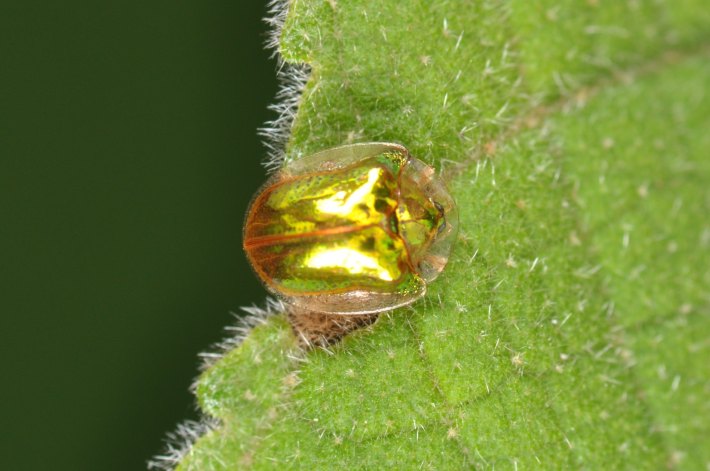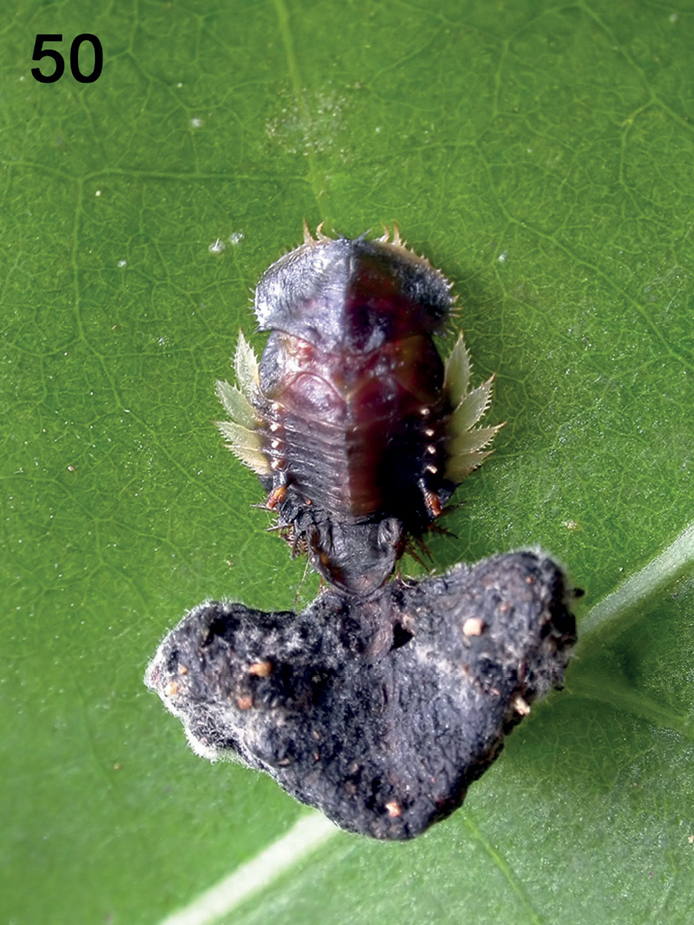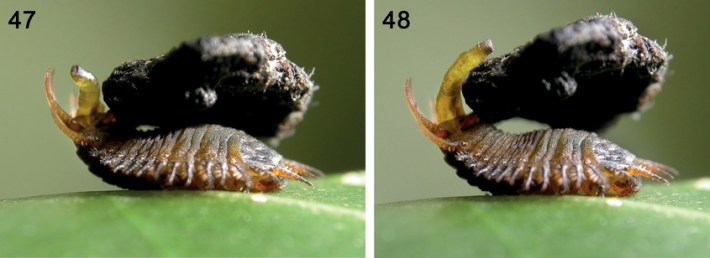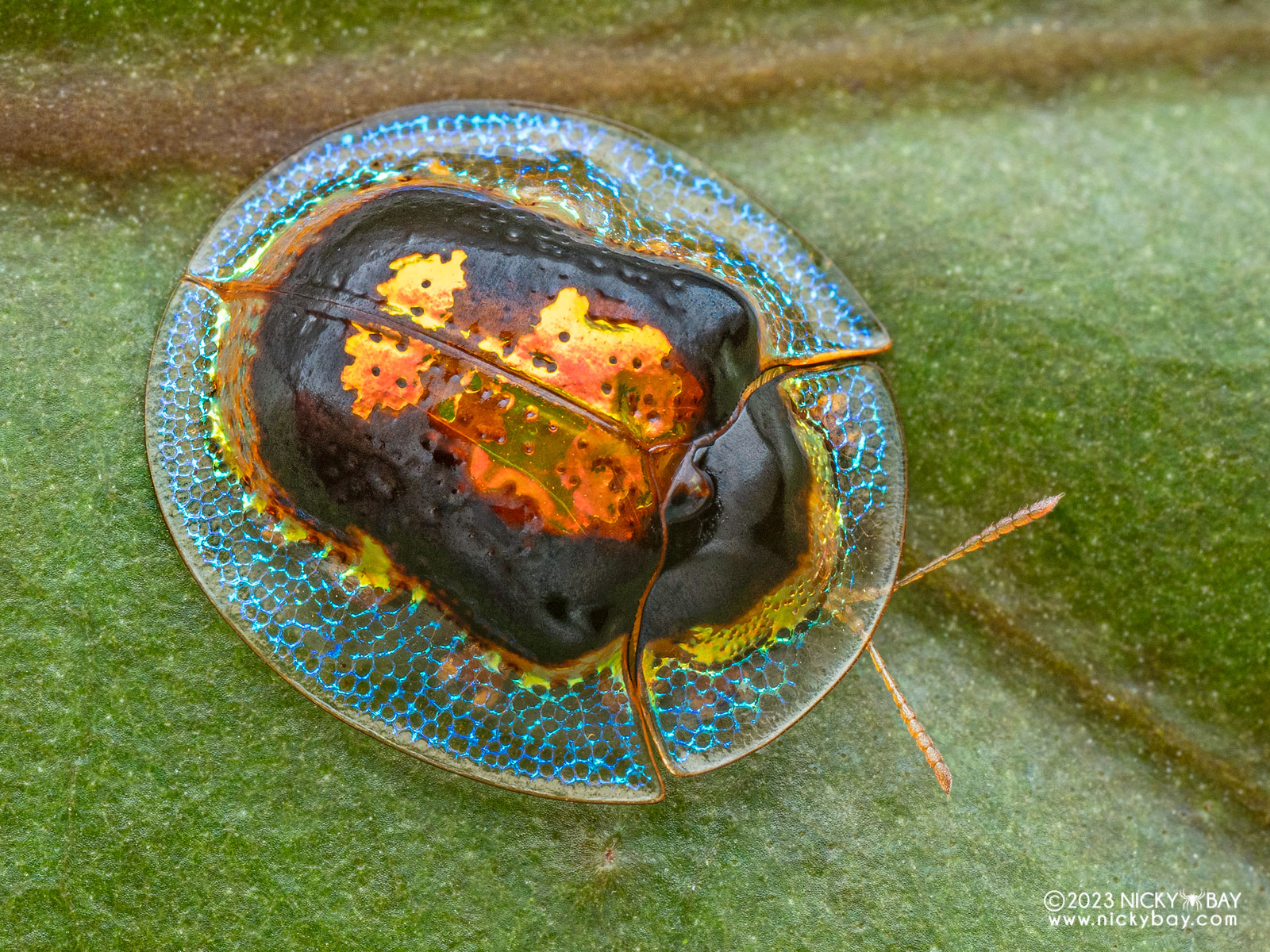All babies poop, but only a few are crafty enough to turn their poop into architecture. Before tortoise beetles molt into adults, they wriggle around as larvae. To protect their soft bodies from the world, the beetle babies shield themselves with a parasol made of their own poop, protruding precariously from their anus. The baby beetles build their dung shields with the help of a special telescopic anus, which can extend and nose around like an elephant trunk to daub new droppings atop their shield. The shields help the larvae pass as unappetizing piles of excrement, escaping the leering eyes of predators.
A paper recently published in the journal ZooKeys describes, in extraordinary detail, the meticulous process behind the poop parasols of several species of tortoise beetles, a distinct shield-building group within the family of leaf beetles, or Chrysomelidae. "It's a beautiful sort of library, of, you know, all of this information about tortoise beetle fecal shields," said Lynette Strickland, a biologist at Boston University who studies tortoise beetles and was not involved with the new paper. "I mean, a very specific library."
Poop umbrellas are no secret to the scientists who study tortoise beetles—a teenage dirtbag phase that the bugs pass through on their way to adulthood. But no research had focused on the detailed art of constructing these shields. "I did not know the tortoise beetle larvae could actually protrude their anus and use it in the construction," Strickland said. "I didn't know that!"
Beyond its stylish flair and some stinky shade, what good is a poop parasol to a baby beetle? Scientists have suggested the shields have multiple functions. They may protect the larvae from the elements, disguise it as droppings or dead plants, or even just dissuade predators and parasitoids with its stink and potential chemical deterrents. After constructing their umbrella, the beetle larvae can move it around—rotating the shield up and down, lowering it on to their back and swaying it from side to side. The larvae even use their shields like a club to thwack away would-be intruders, according to Caroline Chaboo, a research associate at the Nebraska State Museum at the University of Nebraska-Lincoln and an author on the new paper. Some tortoise beetle larvae live in groups, and will form a ring with their heads in the middle and fecal umbrellas pointing outward, a united front for defense. "And then they flick together," Chaboo said.
As larvae, tortoise beetles are drab little grubs. But the adult beetles are true beauties. They get their common name from their domed upper shell, which resemble a turtle shell in shape and gemstones in color. The most audacious of the group may be the golden tortoise beetles, which look like gold nuggets that suddenly sprouted legs. "When you see them land on a plant, you can mistake them for a water droplet," said Chaboo, who said she decided to study tortoise beetles because of their beauty. (When she was narrowing down the focus of her research, she was choosing between tortoise beetles and stinkbugs, which can be more beautiful than you might assume.)

As Chaboo began studying beetles in natural history collections, she quickly saw a gap in the archives. About 99 percent of the collections were adult insects, dried and pinned in drawers; the squishier juveniles were mostly absent. "Each of those insect phases explores the environment in a different way," Chaboo said. "The adults are usually flying and mating, and the larvae are really the ones that are feeding." So Chaboo decided to try to observe tortoise beetles from egg to adulthood so she could document exactly how the larvae built, maintained, and used their poop umbrellas.
Strickland, who rears the Neotropical tortoise beetle Chelymorpha alternans in her lab, has always been enamored by the larvae's poop umbrellas. "I always thought it was really cute," she said. Strickland describes the shape of these specific beetles' shields as a blob. "They really don't put that much effort into it," they said. But Strickland had never actually observed how the beetles built, added to, or manipulated their fecal shields, in part because the larvae are so tiny.
Tortoise beetles are far from the only species with larval architecture. Tiger beetle larvae build mud turrets over their tunnels to prevent flooding. Caddisfly larvae craft themselves ornate cocoons of pebbles and leaves. And the larvae of the pleasing fungal beetle carry a backpack of their molted skins, or exuviae, which may act as a decoy to predators. Feces may be a more unconventional building material, but it is cost-free and somewhat inexhaustible. "Generally insects are very clean animals," Chaboo said, noting that the tortoise beetle poop umbrellas are discrete structures held aloft from the body, unlike some of the other leaf beetles who carry their poop on their body. "Which I find gross," she said. "I even have standards!"

The almost 3,000 species of tortoise beetles produce a variety of fecal architecture, influenced by the nature and arrangement of their own waste. Some species' feces come out wet, and others have drier stools. "Some of it is coming out as long filaments and some of it is coming out as wet blobs," Chaboo said. Some larval tortoise beetles fashion fan-shaped shields and others arrange their feces in whirling coils resembling bird nests.
Chaboo and colleagues focused on comparing the fecal shields of a few species of tortoise beetles, including Calyptocephala attenuata, which is found in Costa Rica, and Cassida sphaerula, which is found in South Africa. The researchers had access to a large population of the South African beetles thanks to Sally Adam, an amateur naturalist and an author on the paper. In August 2021, Adam stumbled upon some tortoise beetle larvae and pupae swarming some yellow daisies on her farm. She had started raising insects as hobby during the COVID-19 pandemic, watching antlions and dragonflies hatch in her office. She raised the tortoise beetle larvae to adulthood and posted photos of the bugs to iNaturalist. Soon enough, someone identified the species—Cassida sphaerula—and informed her the larval and pupal stages of the beetles had not previously been recorded.
Adam began experimenting with Chaboo's guidance. "I felt a bit overwhelmed until I remembered that a retired academic friend has a couple of microscopes and a camera," Adam wrote in an email while also live-streaming the World Sheepdog Trials. Adam removed some shields entirely, leaving the larvae naked, and removed only a part of the shields of other beetles. In both cases, the larvae painstakingly rebuilt their poop parasols. If part of their diamond-shaped shield was broken off, the larvae deposited fresh feces on the broken side to recreate a balanced shield.

The maneuverable, telescopic anus is the only tool tortoise beetle larvae need to build their shields; legs and mouthparts are not necessary here. "It's just a long tube that comes out and moves around, and it can extend almost to the head of the animal," Chaboo said. When Adam saw the anus delicately place a droplet of feces atop the shield, she "squealed with delight," she said. (If you would like to see a tortoise beetle larvae squeezing out a moist droplet of dung to add to its umbrella, knock yourself out.) The South African beetles also layered their old molted skins, or exuviae, into their shields, presumably for reinforcement. "It's not a one-off," Chaboo said. "They build it in the same way. They repair it in the same way, and they always try and balance the shield."
A larger argument the researchers make in the new paper is that tortoise beetle larvae should be recognized as architects in their own right, just like more celebrated builders such as ants, bees, wasps, termites, and spiders. The instinct to build permeates the tree of animal life, as animals have evolved creative ways of protecting themselves from a harsh environment. "People like can always think of beavers right now as an example of an organism that really does change their environment around them to suit them," Strickland said. "These insects are doing this too, right? These little tiny critters are really constructing things and have really complex intricate behaviors." The baby beetles may not yet know how to build a stool, but they can certainly build with it.






